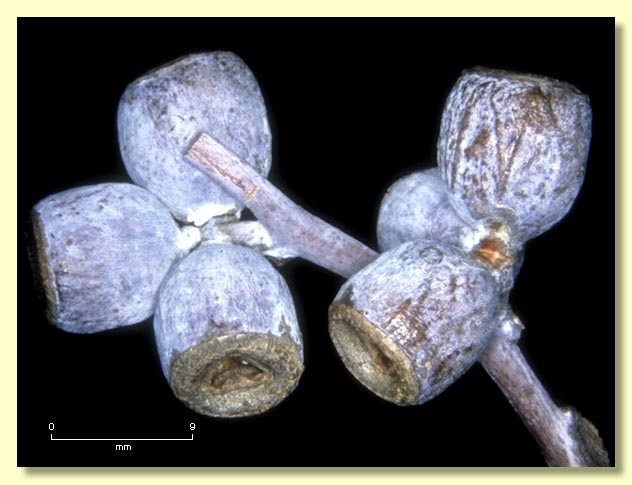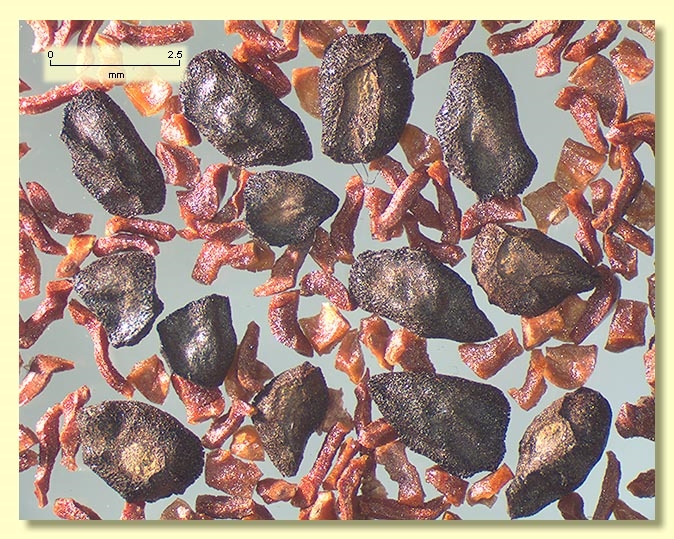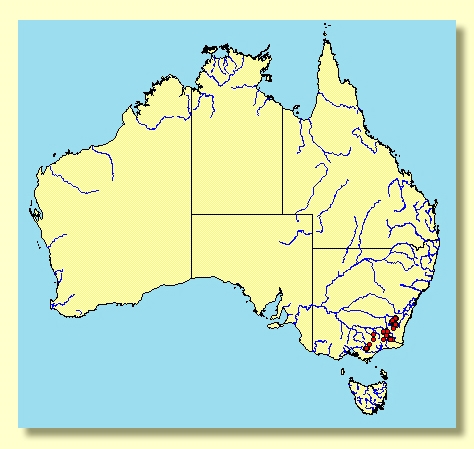Euclid - Online edition
Eucalyptus glaucescens
Eucalyptus | Symphyomyrtus | Maidenaria | Euryotae | Orbiculares
T: Tingiringi [Tingaringy] Mtn, Vic., 20 June 1887, W.Bäuerlen s.n.; holo: NSW.
Eucalyptus gunnii var. glauca H.Deane & Maiden, Proc. Linn. Soc. New South Wales 24: 464 (1899) p.p. T: Mt Baw Baw, Vic., F.Mueller s.n.; syn: MEL, NSW; Nimbo Stn, head of Queanbeyan R., NSW, H.Deane s.n.; syn: MEL.
[E. gunnii auct. non J.D.Hook.: A.J.Ewart, Fl. Victoria 811 (1931).]
Tree to 50 m tall, or mallee. Forming a lignotuber.
Bark rough, fibrous, grey or grey-brown, on lower trunk of trees, shedding in ribbons above; smooth bark of upper trunks, and of mallees, white, orange, brown, green, grey, yellow or pink; horizontal black scars often present on trunk; branchlets usually glaucous.
Juvenile growth (coppice or field seedlings to 50 cm): stem rounded or square in cross-section, usually glaucous, sometimes warty; juvenile leaves opposite and sessile for many pairs, orbicular, often broader than long, becoming alternate, petiolate, ovate to orbicular, 1.5–7 cm long, 2–8 cm wide, margin entire or crenulate, apex usually emarginate, blue-grey or glaucous.
Adult leaves alternate, petiole 1–3 cm long; blade lanceolate to falcate, 6–17 cm long, 1.2–3.5 cm wide, base tapering to petiole, concolorous, glossy or dull, green to blue-green, side-veins greater than 45° to midrib, moderately to densely reticulate, intramarginal vein parallel to and well-removed from margin, oil glands mostly island.
Inflorescence axillary unbranched, peduncles 0.2–0.6 cm long, buds 3 per umbel, sessile or on pedicels to 0.2 cm long. Mature buds cylindrical to elongated diamond-shaped, 0.6–0.9 cm long, 0.3–0.5 cm wide, usually glaucous, scar present, operculum conical to rounded to beaked, much shorter than hypanthium, stamens inflexed, anthers cuboid or cuneate, versatile, dorsifixed, dehiscing by longitudinal slits (non-confluent), style long, stigma blunt, locules 3 or 4, the placentae each with 4 vertical ovule rows. Flowers white.
Fruit sessile, cylindrical, or barrel-shaped, 0.7–1.2 cm long, 0.8–1.2 cm wide, glaucous or non-glaucous, disc usually raised-convex or level, rarely slightly descending, valves 3 or 4, near rim level or enclosed.
Seeds black, brown or grey, 1.5–3.5 mm long, ovoid or flattened-ovoid, often pointed at one end, sometimes lacunose, dorsal surface usually pitted, hilum ventral.
Cultivated seedlings (measured at ca node 10): cotyledons bilobed; stems rounded in cross-section, smooth or slightly warty, glaucous; leaves sessile and opposite for many nodes, orbicular, 1.4–3.4 cm long, 1.4–4 cm wide, amplexicaul, margin entire or subcrenulate, apex rounded or emarginate, glaucous.
Flowering has been recorded in February, March, April and May.
A small to medium-sized tree or mallee of high, well-drained country in south-eastern New South Wales, e.g. Tidbinbilla (ACT) and the Tinderry Range, and of eastern Victoria, e.g. Tingiringi, Mt Erica, on granite.
The tree form of E. glaucescens has a stocking of rough, fibrous bark, while the mallees are smooth-stemmed. Both shed bark in long persistent ribbons. It differs from other three-budded species, e.g. E. viminalis, which prefers valley bottoms and has lanceolate juvenile leaves; E. dalrympleana, which is a smooth-barked tree with light green juvenile leaves; and E. rubida, which is smooth-barked and has glaucous buds, fruits and juvenile leaves. All three species have obconical to hemispherical fruit that contrast with the cupular-cylindrical fruit of E. glaucescens. Another related high mountain 3-budded species of rocky sites, E. perriniana, differs in having juvenile leaves connate around the stem, and these juveniles may persist and form most of the crown of the reproductivly mature tree, and shorter ovoid buds than in E. glaucescens. Yet another related high mountain 3-budded mallee species, Eucalyptus saxatilis, differs in having buds constricted below the middle and larger fruit with prominent disc.
Eucalyptus glaucescens belongs in Eucalyptus subgenus Symphyomyrtus section Maidenaria, a large group of species more or less restricted to south-eastern Australia, characterised by bilobed cotyledons, simple axillary inflorescences, buds with two opercula, stamens with versatile anthers and flattened seeds with a ventral hilum. Within this section, E. glaucescens, with nine other species, forms series Orbiculares having orbicular to ovate juvenile leaves opposite for many nodes, a greyish green crown, buds in threes, and fruit with valves near rim level. Series Orbiculares is confined to far south-eastern New South Wales, eastern Victoria and Tasmania, the species being E. perriniana, E. glaucescens, E. saxatilis, E. pulverulenta, E. chapmaniana, and the Tasmanian endemics E. gunnii, E. archeri, E. morrisbyi, E. urnigera and E. cordata.













